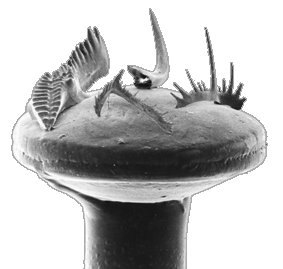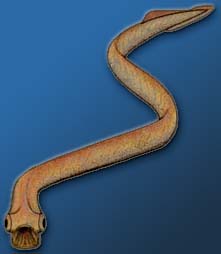|
|
|
|
|
Armed to the teeth |
The account below is based on an article written for children
by Mark Purnell, originally published in Rockwatch (1997). |
|
|
Among our early Palaeozoic ancestors was a creature known as a
conodont; it was small in size, but it had a surprisingly big
bite... |
|
Almost all the fossils that are familiar to us, such as ammonites,
bivalves, trilobites and corals have their own particular types
of hard parts, but their shells are not like the hard parts that
make up our skeletons. Our hard parts are made of enamel, dentine
and bone, and the only animals to make their skeletons from these
materials are known as the vertebrates. The mystery of how and
when we got our bones and teeth is one that goes all the way back
to the origin of vertebrate animals; the day, sometime during
the Cambrian Period, when the ancestor of you, me and all other
members of our corner of the animal kingdom first wriggled its
way across the sea floor.
What was this important animal like? Well, unfortunately it had
no bones or teeth, and so no fossils have been found. But from
what we know about the most primitive fishes alive today, we can
guess that it was probably small, a few centimetres long, and
rather eel-like in appearance. Along its body ran a stiffening
backbone-like structure, and it had a brain and eyes, and a tail
with fins. Without any fossils to help us to understand them,
there are many questions about these early animals that are difficult
to answer. How did they feed? where did they live? when and why
did they first grow teeth and other hard parts? Palaeontologists
have been investigating these questions for more than a hundred
years, but with little real success.
|
|
|
|
|
|
|
|
|
|
 |
|
|
|
This picture, taken using a scanning electron microscope, shows
four conodont elements stuck on a pinhead. |
|
The conodont connection
Recently, important clues about our very early vertebrate ancestors
have been turning up in unexpected places. They have come from
scientific study of a weird group of long-extinct, microscopic
fossils called conodonts. What, I hear you ask, is a conodont?
It's a good question, and until a few years ago no-one really
knew the answer. There were plenty of guesses around, though.
Some conodont microfossils, as you can see in the picture to the
left, look a bit like short spiky combs, and some palaeontologists
thought that they might have been used by a kind of extinct worm
to collect microscopic plankton for food. Or perhaps they were
used by ancient sea snails to scrape up slime from rocks, much
as limpets do now. Other conodont microfossils look more like
claws, and this led some people to suggest that they may have
been used for grabbing and stabbing at food. Some scientists even
had the idea that they might be bits of plants! Lots of conodont
microfossils look like teeth, and one of the best ideas was that
they were the teeth of some type of extinct simple fish-like creature.
But even this idea was really only a sensible guess. There was
just not enough evidence to decide what they were.
Conodont microfossils were discovered almost 150 years ago, and
since then, the hunt has been on for specimens that might tell
us more about them. Palaeontologists didn't have much luck until
1983 when, quite by accident, new fossil conodonts surrounded
by interesting squiggly outlines were found on the surfaces of
330 Million year old rocks in Scotland.
A sausage in the sea
These fossils are some of the rarest known; even after another
13 years of looking there are still only 12 in the whole world.
They are not as spectacular as a Tyrannosaurus, or as beautiful as a perfect ammonite, but these fossils are
more amazing because what these squiggles show is the body of
the conodont. You might not consider that that is particularly
amazing, but think about this: a conodont's body had no bones,
and what the fossils have preserved is the muscles and gristly
bits of the body, and even traces of the eyes! Some of these fossils
are more than 400 million years old, so they make Egyptian mummies
look like they died yesterday, but it is the chances of fossilizing
the soft-parts of the body that make these fossils really amazing.
It's a bit like throwing a sausage into the sea; how long do you
think it would last? Fish and crabs would nibble at the sausage
and after a few hours, the whole thing would be gone. Even if
the fish didn't make a meal of it, after only a few days bacteria
would have rotted it down to nothing. So you can see that the
geological equivalent of preserving a sausage for 400 million
years is even less likely than you winning the lottery! Yet that
is what has happened to the fossils of the conodont body.
So, conodonts are...
 The clues from these fossils tell us that the body of a conodont
was a few centimetres long, and rather eel-like in appearance,
with a stiffening backbone-like structure, a tail with fins, and
eyes (pictured on the right). In fact, it was very like the idea
of what the first vertebrates looked like, and we now think that
conodonts were themselves primitive vertebrates. The big difference,
though, is that their mouths were full of tiny conodont teeth
that we now find as microfossils. In the light of the new ideas
about conodonts, these tooth-like remains have been studied very
intensively. High powered Scanning Electron Microscopes that can
magnify them thousand of times have been used to reveal that the
microfossils are made up of enamel and dentine, just like our
teeth. Scratches have been found on the enamel surface of the
tooth-like fossils and these tell us how the conodonts used them
to slice and crush their food, almost in the same way that we
use our teeth. So we now have a much clearer picture of what some
early vertebrates were like and why they had hard parts. Some
scientists have suggested that they were sluggish creatures, lounging
around on the sea floor, sucking up microscopic plankton for food,
but conodonts conjure up a picture of active, hunting animals
that caught their prey with a complicated and ferocious looking
set of sharp teeth. One of our early ancestors was a small but
very vicious killer!
The clues from these fossils tell us that the body of a conodont
was a few centimetres long, and rather eel-like in appearance,
with a stiffening backbone-like structure, a tail with fins, and
eyes (pictured on the right). In fact, it was very like the idea
of what the first vertebrates looked like, and we now think that
conodonts were themselves primitive vertebrates. The big difference,
though, is that their mouths were full of tiny conodont teeth
that we now find as microfossils. In the light of the new ideas
about conodonts, these tooth-like remains have been studied very
intensively. High powered Scanning Electron Microscopes that can
magnify them thousand of times have been used to reveal that the
microfossils are made up of enamel and dentine, just like our
teeth. Scratches have been found on the enamel surface of the
tooth-like fossils and these tell us how the conodonts used them
to slice and crush their food, almost in the same way that we
use our teeth. So we now have a much clearer picture of what some
early vertebrates were like and why they had hard parts. Some
scientists have suggested that they were sluggish creatures, lounging
around on the sea floor, sucking up microscopic plankton for food,
but conodonts conjure up a picture of active, hunting animals
that caught their prey with a complicated and ferocious looking
set of sharp teeth. One of our early ancestors was a small but
very vicious killer!
Back to Mark Purnell's other webpages

 The clues from these fossils tell us that the body of a conodont
was a few centimetres long, and rather eel-like in appearance,
with a stiffening backbone-like structure, a tail with fins, and
eyes (pictured on the right). In fact, it was very like the idea
of what the first vertebrates looked like, and we now think that
conodonts were themselves primitive vertebrates. The big difference,
though, is that their mouths were full of tiny conodont teeth
that we now find as microfossils. In the light of the new ideas
about conodonts, these tooth-like remains have been studied very
intensively. High powered Scanning Electron Microscopes that can
magnify them thousand of times have been used to reveal that the
microfossils are made up of enamel and dentine, just like our
teeth. Scratches have been found on the enamel surface of the
tooth-like fossils and these tell us how the conodonts used them
to slice and crush their food, almost in the same way that we
use our teeth. So we now have a much clearer picture of what some
early vertebrates were like and why they had hard parts. Some
scientists have suggested that they were sluggish creatures, lounging
around on the sea floor, sucking up microscopic plankton for food,
but conodonts conjure up a picture of active, hunting animals
that caught their prey with a complicated and ferocious looking
set of sharp teeth. One of our early ancestors was a small but
very vicious killer!
The clues from these fossils tell us that the body of a conodont
was a few centimetres long, and rather eel-like in appearance,
with a stiffening backbone-like structure, a tail with fins, and
eyes (pictured on the right). In fact, it was very like the idea
of what the first vertebrates looked like, and we now think that
conodonts were themselves primitive vertebrates. The big difference,
though, is that their mouths were full of tiny conodont teeth
that we now find as microfossils. In the light of the new ideas
about conodonts, these tooth-like remains have been studied very
intensively. High powered Scanning Electron Microscopes that can
magnify them thousand of times have been used to reveal that the
microfossils are made up of enamel and dentine, just like our
teeth. Scratches have been found on the enamel surface of the
tooth-like fossils and these tell us how the conodonts used them
to slice and crush their food, almost in the same way that we
use our teeth. So we now have a much clearer picture of what some
early vertebrates were like and why they had hard parts. Some
scientists have suggested that they were sluggish creatures, lounging
around on the sea floor, sucking up microscopic plankton for food,
but conodonts conjure up a picture of active, hunting animals
that caught their prey with a complicated and ferocious looking
set of sharp teeth. One of our early ancestors was a small but
very vicious killer!